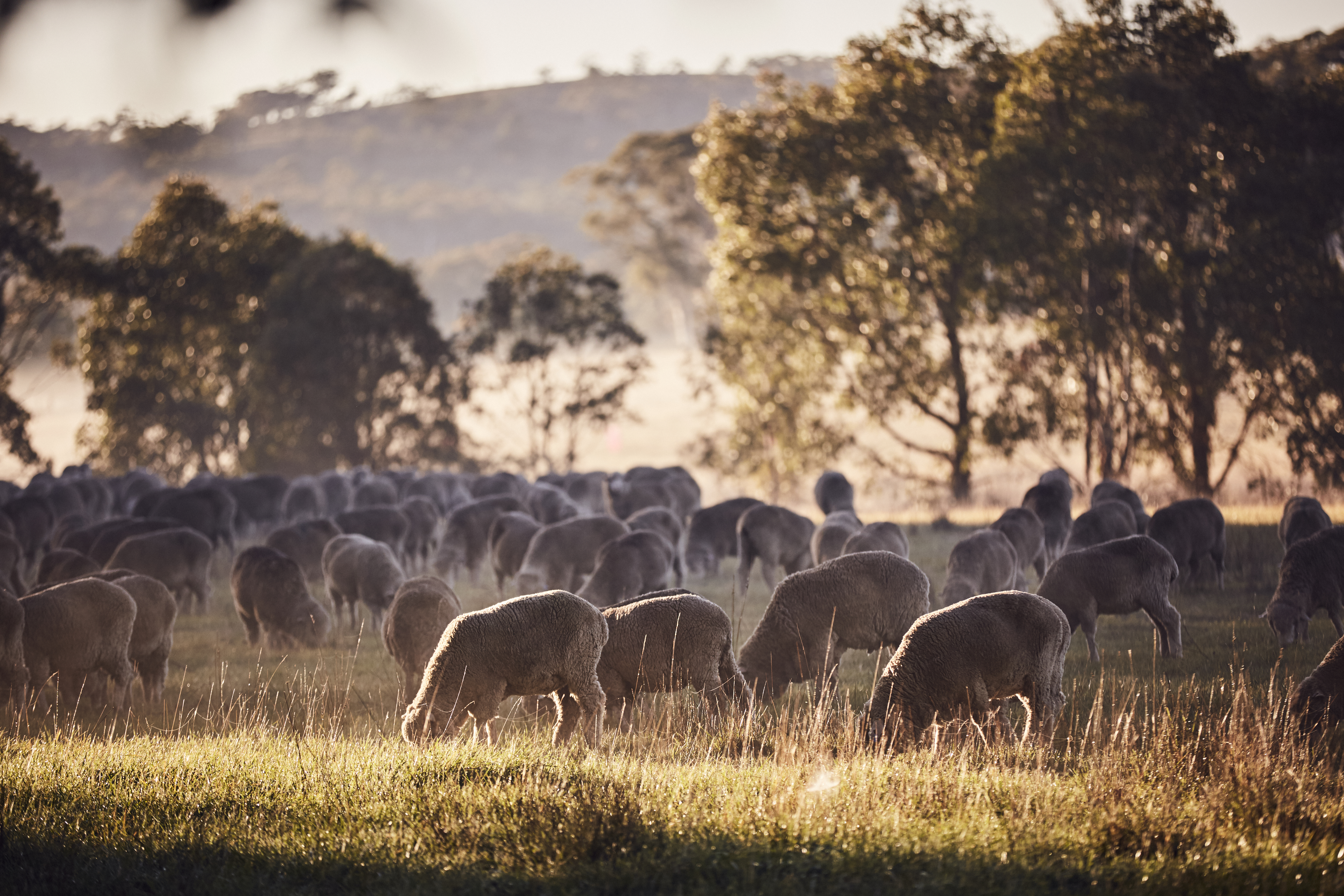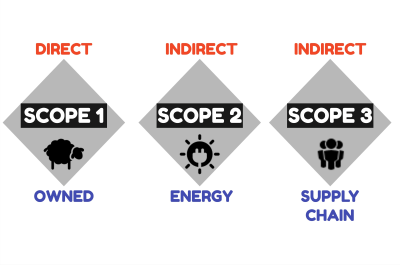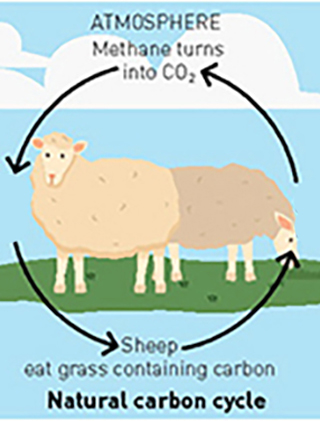Making cent$ of carbon and emissions on-farm

This article helps you make cent$ of carbon and emissions on your farm. We provide you with a quick breakdown of some of the key emissions and carbon terms that are helpful to be aware of to be proactive and take action on your farm and achieve your goal.
Western Australian woolgrowers are getting on with the job of growing more fibre and food, while dealing with unprecedented market, political and seasonal challenges. Despite this, more attention is being paid than ever before to on-farm carbon and greenhouse gas (GHG) emissions - in other words, how sustainably we are running our sheep and farms as a whole. Sustainability remains a key issue in agriculture with the recently released 2023 Community Trust report by Agrifutures Australia highlighting that it is the first priority to build consumer trust.
Australian wool remains in the box seat to help livestock industries become part of the climate solution, primarily due to wool being the environmentally positive fibre choice, however, woolgrowers are still being scrutinised for how sustainably that wool is being produced on-farm. Implementing more sustainable farming practices and raising knowledge and awareness of these is therefore key to improving consumer perceptions of Australian wool. It is also important to keep in mind that in many cases, actions to reduce emissions or increase carbon sequestration on farms can have multiple benefits, such as:
- Increasing farm health and profitability.
- Decreasing costs and increasing productivity, particularly by minimising energy losses in the farm system, and
- Increasing market opportunities as supply chains and consumers become more aware, increasing demand for fibre and food produced with lower emissions.
Be proactive and have a plan
All of our farms produce some GHG emissions, mostly in the form of: methane from sheep; nitrous oxide mainly from fertilisers and manure; and carbon dioxide from fossil fuel-based electricity and fuels. However, our farms also contain trees, plants, grasses and soils that absorb carbon dioxide from the atmosphere and use it to grow. It may seem surprising but, in general, farming produces more GHG than it removes, which contributes to an increased concentration of GHG’s in the atmosphere. These additional heat-trapping gases are increasing global temperatures and causing other changes in local (and global) climates. This will mean further increases in average daily temperatures in WA over time, and less predictable seasonal rainfall patterns (Source: IPCC).
To understand where you sit with your on-farm carbon and GHG emissions, and to monitor progress, a baseline carbon and emissions account for your farm is the best place to start. This will give the total GHG emissions for the farm and the carbon intensity of your products such as wool, meat and grain. This is important so that any decision on how much carbon needs to be captured (sequestration) or emissions reduced (mitigation) is based on actual emissions.
Depending on your goal, you may choose to focus on reducing your farm's impact on climate change (total farm emissions expressed as tonnes per hectare of carbon dioxide equivalents: t/ha CO2 e-) or focus on producing a low carbon product (emission intensity expressed as kilograms of carbon dioxide equivalents per kilogram of product: kg CO2 e-/kg product) to meet a market. Just focusing on reducing the emissions intensity of your wool may not decrease your total farm emissions as you may choose to run or grow more product.
Taking action on your farm
Here is a quick breakdown of some of the key emissions and carbon terms that are helpful to be aware of to take action on your farm and achieve your goal.
The net enterprise emissions on a farm is the total of Scope 1, 2 and 3 emissions and the carbon sequestration. A negative number means that the farm is sequestering more than it emits. A positive number means the farm is emitting more than it sequesters.
Scope 1 emissions are the emissions produced directly from a farm's operations that you have control over. For most woolgrowers the main sources of this would be sheep methane emissions. You can decrease these emissions by breeding more efficient and sustainable sheep, managing the flock to optimise reproductive efficiency, using methane inhibitors (e.g., red algae Asparagopsis), improving the quality of the feed that sheep eat, considering ram selections and breeding objectives to achieve increased reproductive rates, and increasing the amount of wool produced per ha.
Scope 2 emissions are the GHG emissions produced from a farm’s electricity usage. You can reduce Scope 2 emissions produced by your farm by improving the efficiency of electricity use or making choices around power supply. Scope 3 emissions are the GHG emissions produced from a farm’s purchased inputs. Scope 3 emissions can be influenced by your purchasing choices. Choosing suppliers who are low emitters themselves or using inputs efficiently (e.g. nitrogen fertiliser).

Insetting refers to activities that take place on-farm, within the operational control of an entity or the supply chain of a product, that reduces net emissions by sequestering carbon. Offsetting is a term often used for purchasing offsets (or credits) from another entity to reduce net emissions.
By reducing on-farm emissions, woolgrowers can contribute to the carbon neutrality of businesses further up the supply chain. This can then lead to farmers potentially being rewarded in the form of insetting payments or other premiums. These insetting payments may be accrued on top of any carbon credit income that the farm may earn due to soil carbon sequestration.
Going carbon neutral may be relevant to your farm depending on your market and distribution chain. To make credible claims of being carbon neutral, you may need certification and you will also need to reduce emissions as much as possible to avoid ‘greenwashing’. Currently, it may be challenging to be rewarded for being carbon neutral unless you can access specific premium markets through agreements with your wool buyer.
For soil carbon projects, farmers need to register the project and complete an accurate soil carbon baseline assessment before starting any work. During the project, you will monitor and verify carbon sequestered, and then negotiate to sell carbon credits or Australian Carbon Credit units (ACCUs) to a buyer, including those who want to offset their own emissions. Carbon markets in Australia are still maturing. Participating in carbon markets is more likely to be viable for farms with large-scale capacity to increase carbon storage. This may mean significant investment upfront to create transformational change. It is therefore important to consider the costs and risks – as well as the benefits – involved in undertaking a ‘carbon project’.
It is best for individual farmers to go through the process of developing a baseline carbon account for individual farms to tailor the inputs to that specific enterprise. The quality of the results is dependent on the quality and detail of the data used, so accurate farm records are important.
If you are considering going down the path of any of these soil carbon or emissions reduction initiatives, then make sure you have a business case for the costs and benefits of implementing them, and make sure you seek advise from an expert.
Be prepared for what’s ahead
Now that you are across all the carbon and emissions terms and what you can do to improve the sustainability of your farm, remember that reducing GHG emissions and improving soil carbon sequestration is in the best interest of all woolgrowers to improve farm health and profitability, while decreasing costs and potentially opening up new market opportunities. Investing in more sustainable farming practices will also increase the demand for wool from building consumer trust.
There are also increasing pressures and requirements to measure and reduce emissions coming from further up the supply chain. For example, fashion labels, wool buyers, banks, meat processors and supermarkets will all start asking for this data soon as more pressure gets put on them to be more sustainable. Draft legislation is also currently on the cards to get large companies to report on their emissions which will only increase this pressure.
The first steps to set yourself up for future success are to set your business goals, estimate your farm emission sources, and soil carbon levels and identify where to act. MLA recommends that every sheep producer should start using MLA’s free carbon calculator baselining tools to start measuring on-farm emissions. You’ll need a clear plan for how you’ll get your money back if you were to pay for a more accurate baseline data collection for your emissions and soil carbon levels, and pay to register your carbon project or pay to be certified as being carbon neutral. Make sure to seek help and professional advice to understand the best option for your business before taking action.
For more information check out the following resources:
- Sheep reproduction and reducing methane emissions
- Making cent$ of carbon and emissions on-farm
- How to calculate the carbon emissions from your own farm business
- Carbon Calculators - Western Australian example farms
- Greenhouse Accounting Frameworks (GAF) for Australian Primary Industries
- MLA Carbon Calculator - a digitised version of the Sheep and Beef Greenhouse Accounting Framework (SB-GAF) as well as the Grains Accounting Framework (G-GAF) to calculate greenhouses gases produced at a property level.
- AWI Sustainability
Georgia Pugh, AWI Extension WA






